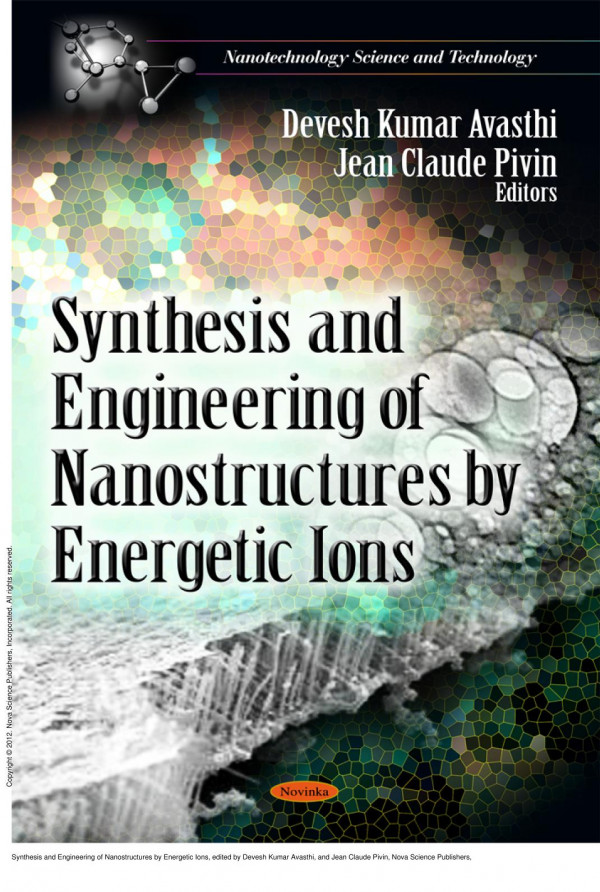

Most ebook files are in PDF format, so you can easily read them using various software such as Foxit Reader or directly on the Google Chrome browser.
Some ebook files are released by publishers in other formats such as .awz, .mobi, .epub, .fb2, etc. You may need to install specific software to read these formats on mobile/PC, such as Calibre.
Please read the tutorial at this link. https://ebooknice.com/page/post?id=faq
We offer FREE conversion to the popular formats you request; however, this may take some time. Therefore, right after payment, please email us, and we will try to provide the service as quickly as possible.
For some exceptional file formats or broken links (if any), please refrain from opening any disputes. Instead, email us first, and we will try to assist within a maximum of 6 hours.
EbookNice Team

Status:
Available4.5
17 reviews
ISBN 10: 1621002373
ISBN 13: 9781621002376
Author: Devesh Kumar Avasthi, Jean Claude Pivin
Part 1: Fundamentals of Ion-Matter Interaction
Chapter 1: Ion Beams and Their Characteristics
Types of Ions and Accelerators
Ion Energy Ranges (keV, MeV, GeV)
Ion Fluence and Dose
Chapter 2: Energy Loss Mechanisms
Nuclear Energy Loss (Elastic Collisions)
Electronic Energy Loss (Inelastic Collisions, Electronic Excitation and Ionization)
Thermal Spike Model and its Application
Chapter 3: Damage Creation and Relaxation in Materials
Point Defects and Extended Defects
Amorphization and Recrystallization
Stress and Strain Induction
Part 2: Synthesis of Nanostructures using Energetic Ions
Chapter 4: Ion Beam Assisted Deposition (IBAD)
Principles and Techniques of IBAD
Growth of Thin Films and Nanocomposites
Control of Microstructure and Properties
Chapter 5: Ion Implantation for Nanostructure Formation
Formation of Nanocrystals and Quantum Dots
Precipitate Formation (e.g., Metal Nanoparticles in Dielectrics)
Doping and Alloying at Nanoscale
Chapter 6: Nanopatterning and Fabrication
Ion Beam Sputtering and Etching for Nanopatterning
Focused Ion Beam (FIB) Milling and Deposition
Self-Organization and Ripple Formation
Part 3: Engineering and Modification of Nanostructures by Energetic Ions
Chapter 7: Modification of Nanoparticles and Nanocrystals
Size and Shape Control
Phase Transformations
Surface and Interface Modifications
Chapter 8: Ion Irradiation Effects on Nanostructured Films
Modifications of Electrical, Optical, and Magnetic Properties
Strain Engineering in Nanofilms
Enhanced Functionality
Chapter 9: Ion Beam Processing of 1D and 2D Nanostructures
Carbon Nanotubes and Graphene Modification
Nanowires and Nanorods Processing
Chapter 10: Characterization Techniques for Ion-Modified Nanostructures
Electron Microscopy (TEM, SEM)
Atomic Force Microscopy (AFM)
X-ray Diffraction (XRD)
Spectroscopic Techniques (Raman, PL, XPS)
Part 4: Applications and Future Directions
Chapter 11: Applications in Devices
Sensors and Actuators
Optoelectronic Devices
Spintronics and Magnetic Devices
Biomedical Applications
Chapter 12: Emerging Trends and Challenges
High-Entropy Alloys at Nanoscale
In-situ Characterization during Irradiation
Theoretical Modeling and Simulation
synthesis lectures on engineering
organic synthesis engineering
engineering nanotechnology
synthesis of a book
synthesis of a book example
Tags: Devesh Kumar Avasthi, Jean Claude Pivin, Synthesis, Engineering